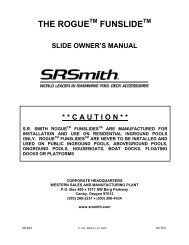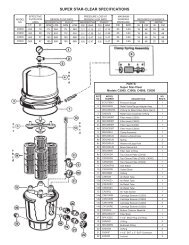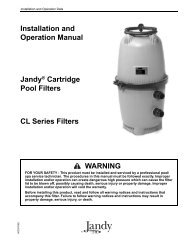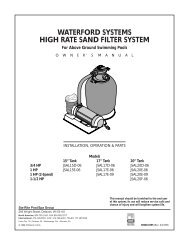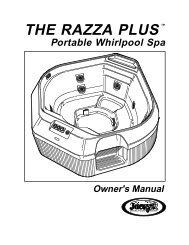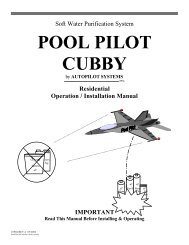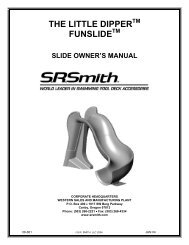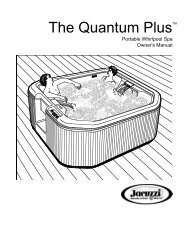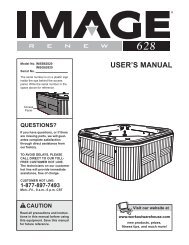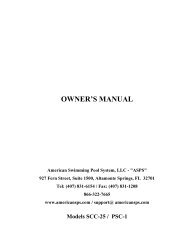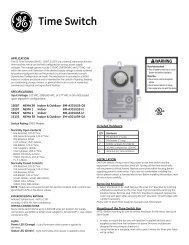Meneely v Smith - Rick English - Swimming Pool Consultant
Meneely v Smith - Rick English - Swimming Pool Consultant
Meneely v Smith - Rick English - Swimming Pool Consultant
Create successful ePaper yourself
Turn your PDF publications into a flip-book with our unique Google optimized e-Paper software.
5/31/2011 No. 18036-1-III. - MENEELY v. SMITH IN…their product literature and to mark instructions and packaging suitably as to pool type “[f]or[their] own protection.” NSPI also instructed its members to affix conspicuous labels totheir products, warning that diving equipment, if installed, must meet NSPI standards for thetype of pool.NSPI members relied on the standards. As set forth earlier, Mr. Dowd stated that in hisexperience everyone in the pool industry conformed to the standards. Jacuzzi, Inc., includedNSPI's depth standard as part of its catalog for diving boards. S.R. <strong>Smith</strong> printed referenceto the standard on the diving board in this case. The label read, “TO BE INSTALLED ONPOOL WITH 7 1/212 FT. DEPTH OR GREATER (TYPE II POOL) Per, N.S.P.I.Specifications Section 211 -Jan. 1, 1972.” Plastimayd Corporation, the company thatmanufactured Mr. Williamson's replacement liner, included a copy of the standard with itsproduct. Both the presidents of S.R. <strong>Smith</strong> and of Plastimayd testified their companiesrelied upon NSPI standards. NSPI members who elected to derate their board from Type IIpools would have been at a competitive disadvantage. Members followed the standard outof economic imperative.We hold the foregoing facts fall squarely within the voluntary rescue doctrine. Bypromulgating industry wide safety standards that pool and board manufacturers relied upon,NSPI voluntarily assumed the duty to warn Mr. <strong>Meneely</strong> and other divers of the risk posedby this type of board on a Type II pool. It failed to exercise reasonable care in performingthat duty, when it did not change the standard after it knew that studies showed the pool andboard combination was dangerous for certain divers.NSPI's attempt to distinguish Brown is not persuasive. It argues that the harm here was notimminent and that its connection with the consumer was too attenuated to impose liability.We disagree with NSPI. The evidence at trial showed that any diver of Mr. <strong>Meneely</strong>'sapproximate age, height, weight, and athletic build was at risk using this board and poolcombination. And, the connection between NSPI and Mr. <strong>Meneely</strong> was no more attenuatedthan in Sheridan, which Brown relied upon in its holding. There, the insurer was held toowe a duty of care to the elevator user when it assumed the responsibility of inspecting theelevator for its owner. NSPI likewise owed Mr. <strong>Meneely</strong> a duty of care when it assumedthe responsibilities of the manufacturers and retailers of the pool and board, for setting poolsafety standards.Folsom is distinguishable, based in part upon the foreseeability of the harm. “ ‘Theultimate test of a duty to use [due] care is found in the foreseeability that harm may result ifcare is not exercised.’ ” King v. National Spa & <strong>Pool</strong> Inst., Inc., 570 So.2d 612, 615, 1A.L.R. 5th 1109 (Ala.1990) (quoting Bush v. Alabama Power Co., 457 So.2d 350, 353(Ala.1984)). “ ‘ “Without evidence that a defendant knew or reasonably should have knownthere was any danger or potential danger associated with that defendant's act or failure to act,any imposition of liability would in essence be the imposition of liability without fault.” ’ ”N.N.V. v. American Ass'n of Blood Banks, 75 Cal.App.4th 1358, 1376, 89 Cal.Rptr.2d 885caselaw.findlaw.com/…/1018182.html 9/14



